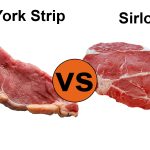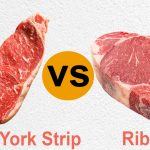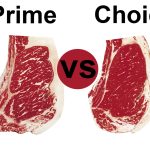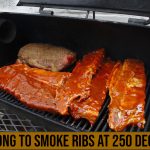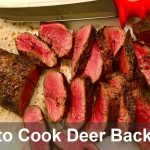Are you stumped when choosing between the two classic steaks Delmonico and Ribeye? Most people are unfamiliar with their differences, making it difficult to decide which one to choose. In this blog post, we’ll explore what exactly sets these two beloved cuts of steak apart so that you can make an informed decision with confidence next time you’re ordering from your favorite menu.
With rich flavors, tenderness and juicy marbling as well as seasonings and cooking techniques all playing a factor in deciding which steak is right for you we’ll help make sure each bite is worth savoring!
What is a Delmonico Steak?
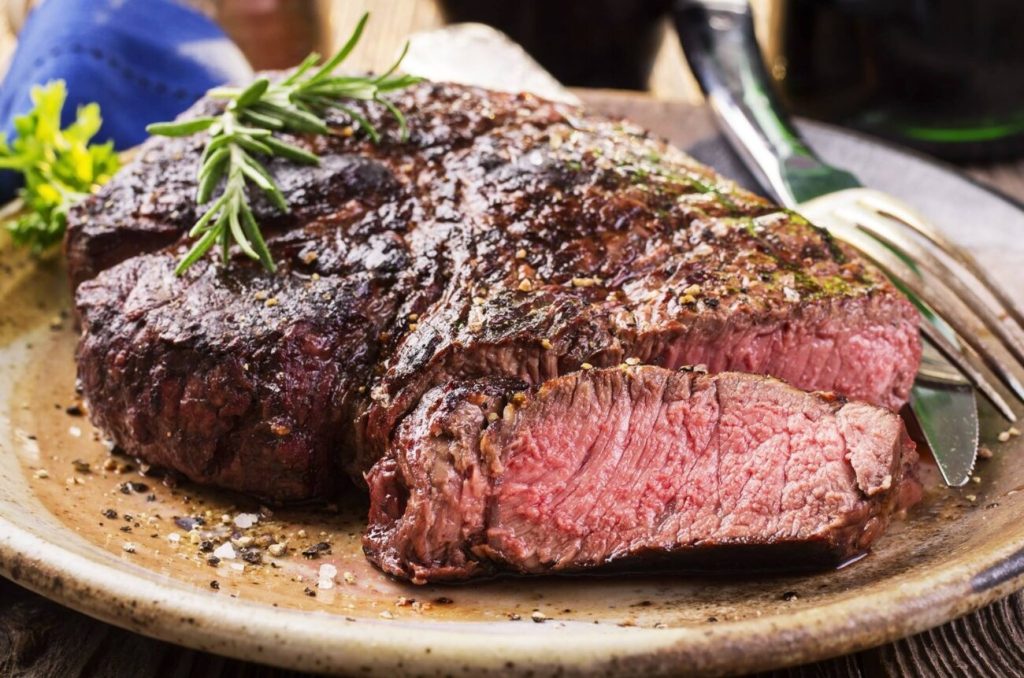
Delmonico steak is cut from the ribeye muscle, which is situated in the middle of the rib section. This cut is known for its superior marbling and intense flavor due to the fat content. It has a smooth texture and velvety feel when cooked correctly. Compared to other cuts of steak, Delmonico can be cooked at lower temperatures as it does not need as much time on the grill to reach desired doneness.
Delonico Nutrition Facts:
Calories: 40
Total Fat: 0g
Sodium: 310mg
Carbohydrates: 8g
Protein: 1g
Vitamin A: 7% of the daily recommended value
Vitamin C: 5% of the daily recommended value
Calcium: 2% of the daily recommended value
Iron: 4% of the daily recommended value.
Delonico is a great low-calorie snack. It contains no fat, plenty of sodium and 8 grams of carbohydrates, making it an ideal option for those looking to cut back on their calorie intake while still getting essential nutrients. Furthermore, Delonico also offers a variety of vitamins and minerals including Vitamin A, Vitamin C, Calcium and Iron – all of which contribute to a healthy diet. Additionally, the protein content (1 gram) helps provide energy throughout the day while still keeping calories low. So when you need a snack that won’t sabotage your diet, reach for Delonico!
What is a Ribeye Steak?
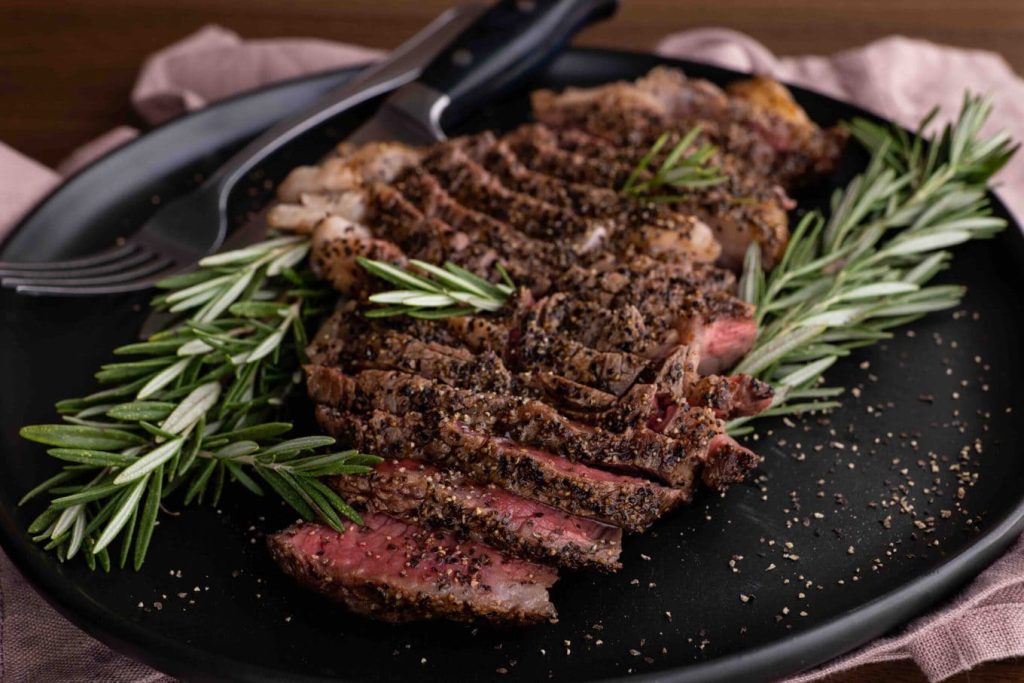
Ribeye steak comes from the same area on the cow as Delmonico but it includes part of the ribs that are still attached. Ribeye steaks can vary in size based on how much bone remains but they tend to have more surface area than Delmonico. This cut of steak is known for its amazing flavor and juiciness thanks to the generous marbling of fat throughout which also helps keep the steak tender while cooking. Ribeye steaks tend to cook faster than other cuts due to their high fat content, so make sure you watch your temperature carefully!
Ribeye Nutrition Facts:
Calories: 124
Total Fat: 8g
Sodium: 58mg
Carbohydrates: 0g
Protein: 16g
Vitamin A: 0% of the daily recommended value
Vitamin C: 0% of the daily recommended value
Calcium: 0% of the daily recommended value
Iron: 4% of the daily recommended value.
Ribeye steak is a great source of protein, containing 16 grams per serving. It’s also an excellent choice when it comes to cutting down on calories and fat, with only 8 grams per serving – making it an ideal protein option for those looking to lose weight or maintain their current weight. Additionally, Ribeye contains no carbohydrates and very low sodium levels (58mg). The lack of vitamins and minerals means that Ribeye must be supplemented with other food sources in order to have a balanced diet. However, the high protein content and low calorie count make Ribeye an excellent choice for those looking to increase their intake of lean proteins. So when you’re in search of a delicious yet healthy meal, reach for Ribeye steak!
What Makes Delonico Unique?
Delonico has all the freshness and convenience of your typical frozen food but with the added benefit of being packed with nutritious ingredients. It is made with only real, natural ingredients and provides a full serving of fruits and vegetables in every bite. This makes it an excellent source of vitamins and minerals – something that can be hard to find in most frozen foods. Moreover, it has no preservatives or artificial flavors, meaning you can enjoy guilt-free snacking without worrying about unhealthy additives.
6 Differences Between Delmonico And Ribeye Steaks:
1. Cut: Delonico steak comes from the chuck area of the cow while Ribeye steaks come from the rib section with some bone still attached.
2. Texture: Delonico is more tender than Ribeye because it contains less fat and connective tissue and therefore requires less time on the grill.
3. Flavor: Delonico has a mild flavor while Ribeye has a bolder, beefier flavor due to its higher fat content.
4. Nutrition: Delonico is lower in calories, fat, and sodium compared to Ribeye which provides more protein per serving but is also higher in saturated fat and cholesterol.
5. Cooking Time: Delmonico cooks faster than Ribeye steak due to its lower fat content.
6. Cost: Ribeye steaks are typically more expensive than Delonico due to their larger size and higher fat content.
Similarities of Delmonico vs Ribeye Steaks:
Both Delmonico and Ribeye steaks are lean cuts of beef that make for an excellent source of protein. Both provide a generous amount of flavor, although the flavor profiles are slightly different. Additionally, both steaks can be cooked in similar ways (grilled, pan seared, etc.) and take about the same amount of time to cook.
Read also:
New York Strip vs Ribeye (Differences Between New York Strip and Ribeye)
Delmonico Steaks vs. Ribeye Pros and Cons:
Delmonico Pros:
– Lower in calories, fat and sodium compared to Ribeye
– Less expensive than other cuts of steak
– Mild flavor that pairs well with a variety of accompaniments
Delmonico Cons:
– Not as tender or flavorful as Ribeye due to its lower fat content
Ribeye Pros:
– Higher protein content per serving than Delonico
– Generous marbling for more intense flavor and juiciness
Ribeye Cons:
– Higher in saturated fat and cholesterol than Delonico.
Delmonico vs Ribeye: Which Is Better?
The answer to this question depends on personal preference and dietary needs. Both of these steaks provide a great source of protein, though Ribeye is generally higher in fat and calories due to its marbling. Delonico is lower in fats and calories, but does not have quite as much flavor as the Ribeye. Ultimately, it comes down to what you are looking for in a steak!
If you’re looking for something with a bold flavor and juicier texture that’s also high in protein, then Ribeye is probably your best bet. However, if you’re counting calories or looking for something leaner that still has plenty of flavor, then go with the Delmonico steak. It all depends on your own personal preference.
Which is Healthier: Delmonico Vs Ribeye ?
Delonico is the healthier choice overall, given its lower fat and calorie content. Additionally, it provides a source of vitamins and minerals that may not be found in Ribeye steaks. However, Ribeye steaks still provide plenty of protein and can be part of a balanced diet when eaten in moderation.
Both Delmonico and Ribeye are delicious cuts of beef that can be enjoyed as part of a nutritious meal. Delonico is the healthier option with fewer calories and more nutritional value while Ribeye has a bolder flavor but more fat and cholesterol.
How To Cook Delmonico vs. Ribeye Steak?
Cooking these two classic steaks requires a bit of finesse since both are full of flavor and can dry out quickly if not cooked correctly. When it comes to Delmonico, opt for lower temperatures and shorter cooking times as this helps retain moisture and tenderness in the steak. On the other hand, ribeye steaks should be cooked at slightly higher temperatures to get the most flavor and juiciness out of them. Make sure you don’t overcook either cut as that can lead to dry, tough steaks.
Delmonico and Ribeye Recipes:
Delmonico steak recipes often call for marinades or sauces to bring out the mild flavor of the cut. Try a classic French Béarnaise sauce with butter and white wine for a delicious accompaniment. Or, try grilling Delonico steaks with a simple dry rub of garlic powder, brown sugar, and dried herbs for a delicious outdoor dinner.
Ribeye steak recipes usually require more intense flavors to complement the bold taste of this steak. Try pan-searing your Ribeye in butter and adding fresh herbs like thyme or rosemary during the last minute of cooking to add flavor. You can also marinate Ribeye overnight in Worcestershire sauce before grilling them up on the barbecue.
FAQs:
Q: What is the difference between Delmonico and Ribeye?
A: The main difference between these two steaks lies in their marbling. Delonico has less fat and fewer calories than Ribeye, but its flavor is more mild. Ribeye has a bolder flavor due to its generous marbling, but it also contains more saturated fat and cholesterol.
Q: How do I cook either steak?
A: To get the best results out of either cut, it’s important to pay attention to the cooking temperature and time. Delmonico should be cooked at lower temperatures for shorter times in order to retain its moisture and tenderness. Ribeye steaks are best cooked at slightly higher temperatures to get the most flavor out of them.
Q: Is a ribeye and Delmonico the same?
A: No, a ribeye and Delmonico are not the same. Ribeye is a fattier cut of steak with intense flavor due to its generous marbling, while Delmonico has less fat and fewer calories but milder flavor. Ultimately, it comes down to personal preference when deciding between these two cuts of beef.
Q: Is Delmonico or Ribeye better for grilling?
A: Both steaks can be grilled successfully if cooked properly. Ribeye steaks should be cooked over direct high heat for short periods of time to get the best results in terms of flavor and juiciness. Delonico is best cooked over indirect heat with lower temperatures in order to retain its moisture and tenderness.
Q: How do I know when either steak is done?
A: The best way to tell if your steak is done cooking is to use a digital cooking thermometer or an instant-read meat thermometer. Delonico should be cooked to an internal temperature of 125°F, while Ribeye steaks should reach an internal temperature of 145°F. It’s important to not overcook either cut in order to get the best results.
Q: Is Delmonico a good cut of beef?
A: Yes, Delmonico is a great cut of beef that can be enjoyed as part of a balanced diet when consumed in moderation. It has less fat and fewer calories than Ribeye but still has plenty of flavor when cooked correctly. Plus, it’s an affordable cut that can be prepared in a variety of ways for delicious meals every time.
Q: What temperature should I cook Delmonico?
A: For the best results, Delonico steak should be cooked over indirect heat to an internal temperature of 125°F. This ensures the steak retains its moisture and tenderness without drying out or becoming tough. It’s important to pay attention to cooking times to make sure you don’t overcook this cut of beef.
Q: What is the best way to cook a Delmonico steak?
A: The best way to cook a Delonico steak is to pan-sear it in butter or oil over medium heat for about 4 minutes per side, or until an internal temperature of 125°F is reached. You can also add fresh herbs like thyme or rosemary during the last minute of cooking for added flavor. Serve with roasted vegetables and red or white wine for a delicious accompaniment.
Q: Why do they call a ribeye Delmonico?
A: The Delmonico cut of steak is named after the famous New York City restaurant, Delmonico’s. The Delmonico’s recipe for ribeye steak was so popular that it became known as the “Delmonico Steak” and has been a classic cut in American cuisine ever since. It’s also referred to as “rib-eye steak” due to its location on the cow. The term “Delmonico” is still used today when referring to this particular cut of beef.
Q: What is the best marinade for a Delmonico steak?
A: A simple marinade made with olive oil, Worcestershire sauce, garlic cloves, fresh herbs such as rosemary or thyme, and a splash of lemon juice is a great marinade for Delonico steak. Marinate your steak for at least 30 minutes before cooking to get the most flavor out of it.
Conclusion:
Delonico and Ribeye are both flavorful cuts of steak that can provide plenty of protein when part of a balanced diet. Delonico is the healthier option due to its lower fat and calorie content, while ribeye has more saturated fat and cholesterol but also offers bolder flavor. When it comes to cooking either steak, make sure you pay attention to the temperature and timing in order to get the best results!
References
- https://en.wikipedia.org/wiki/Rib_eye_steak
- https://menupages.com/delmonicos/56-beaver-st-new-york
- https://en.wikipedia.org/wiki/Delmonico_steak

William Lariviere is a chef and restaurateur with over 25 years of experience in the food industry. He is the owner and operator of Swartzsdeli.com, an online restaurant that specializes in gourmet sandwiches and salads, grill & smoke. He likes to share experience, food, recipes cooking knowledge as well as reviews about restaurant and kitchen products.
William’s goal is to provide his customers with healthy, delicious food that is also affordable and develop Swartzsdeli.com into a comprehensive information site specializing in cooking and cuisine to a new level to help reach a wide range of housewives and readers.


